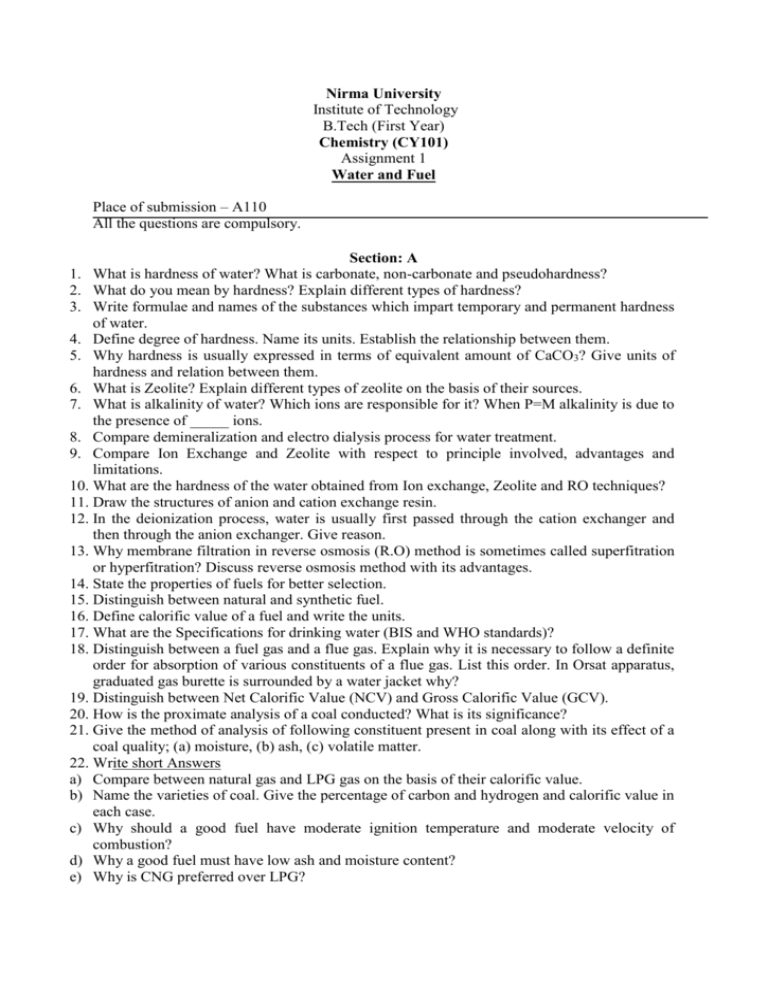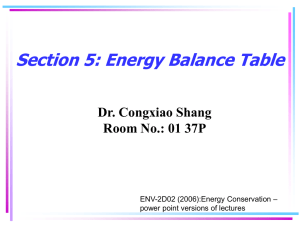Nirma University Institute of Technology B.Tech (First Year
advertisement

Nirma University Institute of Technology B.Tech (First Year) Chemistry (CY101) Assignment 1 Water and Fuel Place of submission – A110 All the questions are compulsory. Section: A 1. What is hardness of water? What is carbonate, non-carbonate and pseudohardness? 2. What do you mean by hardness? Explain different types of hardness? 3. Write formulae and names of the substances which impart temporary and permanent hardness of water. 4. Define degree of hardness. Name its units. Establish the relationship between them. 5. Why hardness is usually expressed in terms of equivalent amount of CaCO3? Give units of hardness and relation between them. 6. What is Zeolite? Explain different types of zeolite on the basis of their sources. 7. What is alkalinity of water? Which ions are responsible for it? When P=M alkalinity is due to the presence of _____ ions. 8. Compare demineralization and electro dialysis process for water treatment. 9. Compare Ion Exchange and Zeolite with respect to principle involved, advantages and limitations. 10. What are the hardness of the water obtained from Ion exchange, Zeolite and RO techniques? 11. Draw the structures of anion and cation exchange resin. 12. In the deionization process, water is usually first passed through the cation exchanger and then through the anion exchanger. Give reason. 13. Why membrane filtration in reverse osmosis (R.O) method is sometimes called superfitration or hyperfitration? Discuss reverse osmosis method with its advantages. 14. State the properties of fuels for better selection. 15. Distinguish between natural and synthetic fuel. 16. Define calorific value of a fuel and write the units. 17. What are the Specifications for drinking water (BIS and WHO standards)? 18. Distinguish between a fuel gas and a flue gas. Explain why it is necessary to follow a definite order for absorption of various constituents of a flue gas. List this order. In Orsat apparatus, graduated gas burette is surrounded by a water jacket why? 19. Distinguish between Net Calorific Value (NCV) and Gross Calorific Value (GCV). 20. How is the proximate analysis of a coal conducted? What is its significance? 21. Give the method of analysis of following constituent present in coal along with its effect of a coal quality; (a) moisture, (b) ash, (c) volatile matter. 22. Write short Answers a) Compare between natural gas and LPG gas on the basis of their calorific value. b) Name the varieties of coal. Give the percentage of carbon and hydrogen and calorific value in each case. c) Why should a good fuel have moderate ignition temperature and moderate velocity of combustion? d) Why a good fuel must have low ash and moisture content? e) Why is CNG preferred over LPG? 23. Explain the determination of net calorific value (NCV) of a coal from the data of ultimate analysis. 24. Define alternative fuels. Explain briefly about compressed natural gas (CNG), Bio-diesel and Liquefied Petroleum gas (LPG). Section: B All questions are COMPULSORY 25. A sample of water on analysis was found to contain the following impurities: Impurities Ca(HCO3)2 Mg(HCO3)2 CaSO4 MgSO4 Concentration 6.46 5.84 7.60 5.80 (in mg/L) Mol. wt. 162 146 136 120 Calculate the temporary, permanent, and total hardness in ppm, ํCl, and ํFr. 26. A zeolite softener was 97% exhausted by removing the hardness completely when 10,000 L of hard water sample are passed through it. The exhausted zeolite bed required 2000 L of 3% NaCl solution for its complete regeneration. Calculate the hardness of water sample. 27. A sample of coal was analyzed as follows: Exactly 1.5 g of coal was weighed into a silica crucible. After heating for one hour at 100° C, the residue weighed 1.415 g. The crucible was then covered with a vented lid and strongly heated for exactly seven minutes at 950 ± 20° C. The residue weighed 0.528 g, the crucible was then heated without the cover, until a constant weight was obtained, and the last residue was found to weight 0.254 g. Calculate (i) The percentage results of the above analysis (ii)To which type of analysis does the above description and what are the significances? 28. A Zeolite softener was used to remove hardness of 90,0000L of hard water completely. The softener required 4500L of NaCl solution containing 16 g/l of NaCl for regeneration. Calculate the hardness of hard water in ppm. 29. In kjeldahl’s method 0.4422 g of a coal sample was digested with conc. H2SO4. The NH3 evolved on distilling the resulting solution with excess of NaOH solution was absorbed in 50 ml of 0.5N H2SO4 solution. The residual acid required 59.5 ml of 0.5N KOH for complete neutralization. Find the %N. 30. Calculate the high calorific value and low calorific value of a coal by sample having the following ultimate analysis: C = 80%, H = 3.5%, O = 2.8%, S = 5%, N = 1.5% and ash = 7.2%. 31. 0.35 g of a coal sample on burning in a combustion chamber in the current of dry oxygen was found to increase the weight of U-tube with anhydrous CaCl2 by 0.085 g and KOH tube by 0.52 g. Find C and H percentage in the coal sample. But from the ultimate analysis it was found that the given coal sample also having the following: O = 5%, S = 2.8%, N = 1.5% and ash = 7.2%.Calculate the high and low calorific value of the given coal sample. x---------------------------x-------------------------------x




